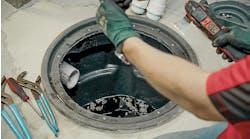Did you know that for every 100 Btu of fossil fuel, one cubic foot of air is required for adequate combustion? We've always known about the need for providing combustion air, yet that never quite registered as a burning issue - until now.
So much has changed this past decade:
Houses insulated so tightly that we found it necessary to introduce fresh air to offset excess humidity and off-gassing of volatile organic compounds from building components that adversely affected indoor air quality; a variety of combustion venting that includes atmospheric chimney sidewall or B-venting, indirect (exhaust only) with dilution of drawn-in room air lowering the net stack temperature so that PVC venting can be utilized; semi-direct venting where a lose-fitting box covering a burner “draws” in outdoor (and indoor) air; and, finally, true direct venting that incorporates sealed combustion so that virtually all combustion is supported by outdoor air.
Building construction is constantly evolving with the advent of green building - the Leadership in Energy and Environmental Design - and a better awareness of parasitic energy losses caused by things we can control, like combustion-related infiltration. We should recognize and deal with those areas where we are responsible for a building's performance - or lack thereof.
I was recently reading a piece depicting our trades by someone in the general contracting field who noted we (mechanical contractors) are no longer HVAC, but rather, HAC because we'd long ignored and forgotten the ventilation issues. Being labeled an HAC raised my HACkles at first, but after taking a few deep breaths, I realized he was more right than wrong.
We have two primary offenders under our purview where infiltration is concerned: water heaters and heating appliances. Let's stick with water heaters for starters because they represent a daily infiltration load on any given structure.
If we assume a 50-gal. per day usage and assign a 0.63 EF (Energy Factor, which is standard for atmospheric tank-style water heaters), we'll witness an hour's run-time per day and need 397-cu.ft. of combustion air. In one year's time, that's 144,905-cu.ft.!
And, we're competing with bath fans (assuming they were properly vented to the exterior), kitchen exhaust hoods, dryers, fireplaces, whole-house fans, other combustion equipment vented to the exterior, can-lights recessed in ceilings, HAC ceiling registers and the overall chimney effect affecting the building - which can be greatly increased by wind whipping over a roof-line - just as wind crossing a plane's wings “lifts” the ship.
With all those things adversely affecting the building's ability to retain Btus, it's a miracle we can overcome such obstacles to provide even a moderate level of comfort for our customers!
Bear in mind that the 144,905-cu.ft. of direct combustion-related infiltration did not include draft dilution at the atmospheric vent hood or the other 23 hours of constant draft where room air, air that's been heated or cooled, is drawn up the chimney and wasted to the great outdoors. If Btus were visible as they infiltrated/exfiltrated our customers' homes, we'd have long ago resolved this issue!
Next comes the heating side of our responsibility. In my area of the U.S., we calculate Btu loads using 2,250 run-hours. If a home needs a 100,000-Btuh heating appliance and that's a chimney-vented 80%+ efficiency model, the appliance will require 2,250,000-cu.ft. of combustion-related infiltration!
What's the cost? It takes 20-Btus to raise 1,000-cu.ft. of air 1°F. If the mean average for outdoor air we're drawing in for combustion over the course of one winter season is 45°F, then we can assume the cost to be 2,250,000 (heating) + 96,603 (water heating) + 1,500,000 (flue-related draft exfiltration) = 3,846,603-cu.ft. of infiltration ÷ 1,000 = 3,846.6 × 45 = 173,097-Btus of parasitic energy lost up the flue!
But, that's just the direct costs. The hidden costs include the comfort issues related to drafts we are creating within the living spaces, and the negative aspects of compromising insulation values as moisture is pulled into wall cavities and condenses. Indoor air quality is adversely affected and the potential for mold growth in hidden spaces becomes more enhanced.
Will we LEED or be led? Will we, as plumbers, step up and be counted in the race towards energy conservation and reduction of our collective carbon footprint? Like it or not, our customers are looking to us for leadership as finite fossil fuel resources dwindle and become ever more expensive. High efficiency sealed combustion appliances must become the norm, rather than the exception, as we embrace the inevitable changes already in progress.
Catch the wave: hang 10.
Dave Yates owns F.W. Behler, a contracting company in York, Pa. He can be reached by phone at 717/843-4920 or by e-mail at [email protected].
All Dave Yates material on this website is protected by Copyright 2008. Any reuse of this material (print or electronic) must first have the expressed written permission of Dave Yates. Please contact via email at: [email protected]

